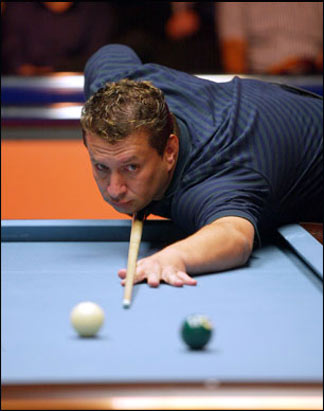Chris:
If you don't mind my taking a swing at this ...?
There are two styles of the snooker stance; the boxer stance, and the traditional square-on snooker stance.
Andrew Green describes it well in this video:
http://youtube.com/watch?v=3PJQMCh0f0U
Neil Maxman: close-up of foot placement for snooker stance:
http://youtube.com/watch?v=TRDwmGXTL1Y
You'll notice in the first video (the Andrew Green one) that the planted foot (the right foot for a right-hander) is slightly pointed outwards, even though it's stepping right on the line of the shot. This affords the slight rotation of the hips that (methinks) Pidge is describing.
The traditional snooker stance, however, has the planted foot stepping on and pointing 100% into the shot (sides of the foot are parallel with the shot line itself), and this stance requires the hips to seat inwards slightly. What I mean, is if you go to a tall mirror and stand in front of it, watch what happens when shift all your weight to your right leg (make your left foot come off the floor slightly). You'll notice your hip "seats inwards" (shifts to the left) such that your hip is now 100% parallel with the outermost right edge of your thigh. In the traditional snooker stance, you obviously don't place all of your weight on that leg, but most of it, and it achieves the same thing -- the hip seats inward, and gives you clearance such that your right hand (the grip hand) doesn't collide with the edge of your hip. This, I believe, is the stance that Jaden describes.
Yes, the boxer stance requires a locked leg just like the traditional snooker stance, but they achieve that "hip clearance" in different ways -- the boxer stance has a bit of a rotation of the leg itself (which moves the hip out of the way), while the traditional snooker stance uses a "seating / shifting" method.
Hope that helps!
-Sean


